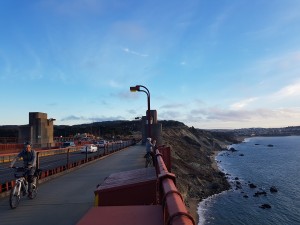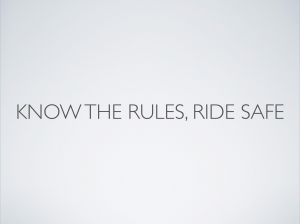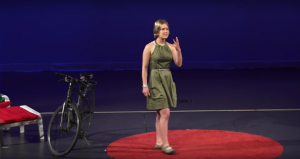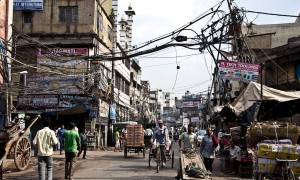Overall I feel accomplished, i am happy with the work that i produced and how i delivered my presentation. For this presentation i had to do less research compared to my past ones. As i came up with the model of the shop that i was proposing i did not need to look up much information. This was a positive as I was able to include a lot more personal and creative work. In my presentation I included some background information about myself because i thought that in order for this particular speech to be successful i needed to asses my credibility. Credibility is something that we discussed early in the semester as being important in order to have your point heard. Moreover I thought that my presentation had a solid structure and it was backed up well by visual aids on the board. This allowed the audience to easily follow the transition of my ideas. I tried to involve the audience by creating the hashtag ‘#BuildUSFaBikeShop’ and leaving in at the end. By doing this I encouraged them to take an action and not only i opened the discussion of my topic to a bigger audience. I was both surprised and happy when i saw that a couple of people did post the hashtag on twitter. In class we talked about including different types of material and media in our presentation in order to keep it entertaining and ‘fresh’. For the first time I included a video in my slides, I thought that it would have been a strong way to deliver the message that I wanted to get across. Fortunately, on the day all the technology worked and the video produced the effect that I was looking for. In my opinion various people had strong presentations and it was very interesting to see how Matthew and Dina went about to create their video presentation. I thought that Maelynne had a very good topic, it included a relevant issue, that of homelessness, and she came up with a good proposal to help them, nice! We talked a lot about Voice lately in class, I thought that someone who was clearly really prepared and gave her max to keep energized throughout her speech was Ashley. Her tone of voice was joyful from the beginning to the end and it definitely influenced the audience positively. In conclusion, as always, it’s an interesting experience to give and hear a presentation.
S3 presentation Video practice 3
In this final rehearsal video I imagined myself presenting to the class, i do this to try to be more relaxed and on point when I get to the actual presentation. I think that I presented well in this last rehearsal, i felt calm and confident.
In this second video practice i used my laptop to practice presenting the slides along side my speech. I need to change the slide at specific moments to go with what i am saying so it was useful to practice this. In the next video i will practice standing up, as if i am presenting to the audience.
S3 Perestation, Video Practice 1 – Demosthenes style
For this rehearsal I took inspiration from Demosthenes but I didn’t make it to the ocean. With the help of a friend, I recorded myself practicing my speech outside in the open, far away from the camera. This was useful to practice my voice projecting and to make sure that i will be heard. For my next video i will practice presenting with my power point.
S3 Presentation, Speech write out
Hello everyone, today i will be addressing our University’s board members,
My name is Ettore Crocetti Marzotto and I am here today to propose to you that USF should have its own Bike Rental shop.
Before we get into the issue i would like to tell you a bit about myself, I was born in Tuscany, in the center of Italy. Over there, there wasn’t much of a bicycle culture, people preferred to ride motorbikes or drive to get to their destination. So, to be honest, before coming to San Francisco i didn’t know much about bicycles at all. It was when i came here that i truly discovered the utility of a Bicycle. I expanded my knowledge on bikes greatly and i can even call myself a proud owner of a bicycle.
But sadly not everyone can, and that’s a problem.
Bikes are expensive which means that a big proportion of our college students might not be able to afford one. Just by performing a quick investigation where i asked 15 of our students if they had a bike i found that only 4 of them did. Another problem is that there is little information handed out about different aspects of biking, such as what bike to chose or knowledge of the bike rules. Something that I discovered gathering evidence for my past presentation was that little knowledge of the bike rules might cause people to be afraid to ride in San Francisco.
We should aim to reverse that fear and make bikes available.
Resolving this issues would not only benefit USF students by giving them a bike which will allow them to do numerous things but furthermore it would also benefit USF itself. By improving the the University’s image and making it unique from other schools.
So how can we do this?
I have come up with the idea to implement a bike shop right on our campus. This shop would be able to provide students with a bike thought different memberships. These can be broken down into a “weekly memberships”, a “monthly” or a full “semester” one. With these memberships a student will have the choice of 3 different types of bikes to choose from, either a Road bike, a trail bike or a hybrid. I believe that it is important to have this choice so that each student will be able to find the right bike that fits their needs. Of course, with the same memberships, students would also receive a helmet and U-Lock to keep themselves and their bikes safe.
Furthermore as I have identified, another problem in our campus is that people are poorly educated on bikes. Our bike shop would not only aim to provide students with bicycles but it will also be involved in teaching and spreading information about bicycles. This section of the shop would be involved in advocating biking as a mode of transportation, to support clean air transport and to show people the benefits of biking. Secondly, it will have workshops to teach and show that riding in San Francisco can be safe as long as you follow the rules.
The benefits are clear, we would have a more sustainably friendly campus and our effort to benefit our students, would be recognized. Altogether this will create a super positive image for USF and it will set us apart from other Universities. Moreover we will strive towards an environment where everyone will have the possibility to posses a bike. This will allow our students to enjoy and be part of, the huge bicycle culture that we have here in San Francisco.
Such as this,
(Critical Mass Video)
Let’s not deny our Students this much fun! Build USF a Bike Shop
#buildUSFaBikeShop
YouTube Voice
I believe that there are different ways in which “youtube voice” can be used and delivered. I think that this could depend on what kind of audience the youtuber wants to reach.
For example in Francesca Ramsey “5 tips for being an ally” she uses an overall more informal and conversational language, possibly aiming to reach a wide audience. Furthermore Francesa clearly displays many of the linguistic components discussed by Julie Beck in “The linguistics of YouTube voice”. Such components that Francesca uses in order to keep her viewers watching are; Overdressed vowels, Aspiration and many more. These are more subtly used is the language that Senelma Heinoen chose to use in her TED Talk “Spokes Up”. She speaks at a more formal event with a more academic audience. Personally I was moved by her speech, her message was strong and she delivered it very clearly with a lot of passion. Towards the middle, after assessing her credibility with the use of anecdotes and personal experience, Senelma transitions to talking about the benefits of commuting on a bike. She decides to focuse on 3 reasons and similarly to Francesca and many other youtubers, Senelma uses her hand to display the number 3 at the same time as she says “I will focus on three”. This is effective in strongly transmitting the point that there are 3 reasons.
Both videos use some degree of youtube strategies and both are effective in their purpose to deliver their message to the audience. However, there is a clear distinction in the level of “YouTube Voise” that is used in the two videos. In her video, Francescas’ attention grabbing way of speaking fits what people expect from a youtube video and has been proven to be an effective way to communicate to the audience of these kind of videos. On the other hand, Senelma doesn’t try to stretch out vowels or sneak some between consonants, this is because her audience expects a more academic tone. In conclusion i think that you have to keep in mind the audience that you are addressing when considering using “YouTube Voice”
S3 Presentation. Topic Proposal
Hello everyone,
Around campus i have identified a problem; there is no storage for bikes and furthermore it is hard for people to buy a bike. This could be because of poor knowledge of the bike rules of the road, which might cause people to be scared to ride. Another difficulty in getting a first bike is that they can often be expensive for a college student.
I will propose a solution to the university board members, they will be interested because it will aim to improve transportation for students, faculty and give USF and overall better image.
My idea is that USF should have its own bike rental. Giving different kinds of memberships people can sign up to get a bike. Moreover this will provide storage for everyone who already has a bike. The shop could provide repairs or work stations, for personal use. Finally I will suggest that the shop also should provide workshops to improve the knowledge on safe riding.
Thank you
Reflection to New York Times articles

After reading these two articles i had a similar reaction as Daniel Duane did in “Is it O.K to kill cyclist” when he writes about seeing an SUV hit another cyclist which brought him to reconsider cycling. The reality of the dangers of the road hit me and left me confronted between two different opinion on how we should ride.
Before reading the articles i had a confident approach towards riding fast in the city, while reading “if Kant were a New York Cyclist” i was thinking about riding even more freely but it was went i read “Is it O.K to kill a cyclist” that i started thinking that maybe riding so fast is not such a good idea.
I can very much relate to “If Kant were a New York Cyclist”, especially with how Randy Cohen describes his riding style and thinking. Since i was young I always enjoyed riding all kinds of different vehicles as fast as possible and in the most tricky bits, it was thrilling and fun. I was always aware of the possible dangers and drove responsibly, knowing my limits but pushing myself to improve. In his article Cohen says “I choose my riding style mindful of my own safety and that of my neighbors, but also in pursuit of happiness.”
Although for me, coming from the country side, riding in the city was a change. You can’t only think about yourself and your ride but you have to be aware of the other million of people circulating around you. Cohen says “Drive dangerously, you’re apt to injure others; ride dangerously, I’m apt to injure myself. I have skin in the game. And blood. And bones.” I have been riding in the city for just under two months now, at first i had to get used to even checking if cars were approaching at every stop sign, i also needed to remember to signal my turns, all basic things but not easy to remember for someone that is not from the city. Fortunately, the San Francisco bike coalition, which i was invited to become a member of by my Speaking of Bicycles class, offered some workshops to learn the rules and i was able to understand better what the safe way to ride is. This changed my riding style towards a safer one but every now and again i would still not fully stop at every crossing or sometimes ride on the sidewalk.
Cohen argues that car rules do not necessarily fit with how you would ride a bike, but most bike rules are as he says “a clumsy misapplication of motor vehicle laws”. He states that if the laws were more directed towards bikers more people would respect the rules. If more people respected the rules the risks of injuries would go down. Daniel Duane agree saying “Laws in most states do give bicycles full access to the road, but very few roads are designed to accommodate bicycles, and the speed and mass differentials” He further adds the point of speed mass differentials something that we examined in class as an important factor of safety. Therefore, maybe if the bike lanes and rules were more appropriate for bikers i would be able to ride faster and safer?
Duane unlike Cohen is against cyclist who ignore traffic rules and believes them to be “immortal, entitled fools.” and that this could cause people to see them as risk takers and who therefore deserve their fate. He tries to get people to understand that “cycling is’t sky diving”, but the opposite, that “it’s a sensible response to changing transpiration environment”. Duane at the end encourages us to; “Every time you get on a bike, from this moment forward, obey the letter of the law in every traffic exchange everywhere to help drivers (and police officers) view cyclists as predictable users of the road who deserve respect.” Duane makes a good argument, and ethical one that aims towards a more civil style of riding, using strong evidence, such as death reports, to convince the readers.
In conclusion, i am left torn between what is moral – riding appropriately and respectfully as is suggested by Duane or riding in a fun, enjoyable and maybe a bit reckless way like Cohen suggests. Something that i am sure about and agree with both of the writers is that bike laws should be more appropriate, even by having all designated protected lanes for bikers the levels of fatalities and injuries would go down and riders could ride as fast as they’d want to.
Byrne Reflection Post
For David Byrne, a former musician a now an artist, it was riding around the cities in a bike that allowed him to see things that he would have otherwise never seen, and changed who he was. This thinking was also advocated earlier in 1991 by American political scientist Robin Leblanc who said that we see cities differently depending on how we choose to move through them and that this affects what we see and how we understand things. In summery that our perspective of things can affect who we are, or in other words our identity.
There were many different points that Byrne makes in his writing, i would like to focus on a point that particularly stood out for me, the tech boom and how it revolutionized not only the economy but also how people lived and interacted. Byrne explain that in order for the dot-com boom to develop people had to be ready to live entirely online, which would have meant a major shift in how people interacted and lived their lives and most people were not prepared to do that. It was later with the Web 2.0, a more socially interactive and responsive commerce-based web sites, and wifi that allowed more mobility which meant that some of those imagined shifts might actually occur. These shifts impacted several aspects of community and interaction, the hippy community; first allowing them to have affordable houses and then later being pushed out and onto the streets, the tech boom created a social barrier for many people and circumstances, it also gradually reduced face to face interactions.
I was further intrigued by this social evolution due to technology after reading Byrne’s essay on Istanbul, where he talked about many different countries For example he mentions Turkey, Syria, Greece, Egypt and even India. I thought that one thing that all these countries have in common is a similar level of technological development. That being present, with high use of phones, computers, tv etc but that it has not taken over most daily operations like in Europe or America. This made me reflect on the kind of interactions that these countries have and their economy. Take as a specific example Istanbul, situated in Turkey it sits on top of a beautiful hill mostly surrounded by water, this active town, like many other in the countries listed above, relies on people leaving their homes and actively interacting with the community. By going to the market, instead of ordering online, or communicating by voice often to spread information, similar to how Byrne saw San Francisco before the tech boom.
In conclusion, i am left thinking, will places like Istanbul also move towards and economy that is based more on the internet as technology in their country develops? and if so what will this mean for their level of social interaction, will it go up or down?
S2 Reflection
 I will now reflect on how i think i did in my S2 presentation.
I will now reflect on how i think i did in my S2 presentation.
My S2 presentation was on a correlational investigation on wether or not a correlation exist between knowledge of the bike rules and perception of his safe it is to ride in San Francisco.
I feel that overall the content of my presentation was strong. I not only presented evidence but I also showed how i went about to gather that evidence and why i though that it was a good idea, or not to do so. For example i evaluated the different points to why choosing a survey was an effective use of gathering evidence and how it fitted the purpose of my study, such as talking about the format i chose and questions that i asked. A positive point but not yet a complete strength is that i feel that i was more able to make contact with the audience and engage them with my speech. Something we discussed as being one of the key concepts of public speaking at the begging of the semester. I was able to to this by giving out the leaflet and asking the audience to participate. My main weakness this time was not memorizing the speech, i needed the help of the paper to present and i feel that it made my speech a little less involving. Because at first i had some difficulties with the statistical analysis it caused me to sped a lot of time on that and less on memorizing my speech.
In writing my speech i was keeping in mind the advice from the video we saw on how to make a successful conclusion, so i included the 4 steps that are talked about in the video. I used a signpost: ’in conclusion’, i gave a summery: ‘because of the limitation discussed in my speech such as..’ i restated my main point: that a correlation could exist and, i used a clincher: ‘Know the rules and ride safe’ along side a slide show page to make an effective and memorable conclusion.
I thought that Helen was very good, as she has been in the past, at presenting with a relaxed tone that makes her presentational all together enjoyable to listen.
My plan for improvement is to organize my time efficiently. I should leave enough time at the end to prepare as much as possible for the presentation.


